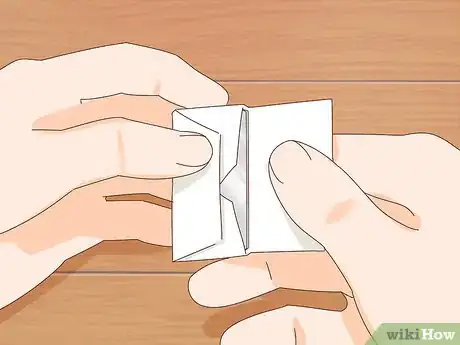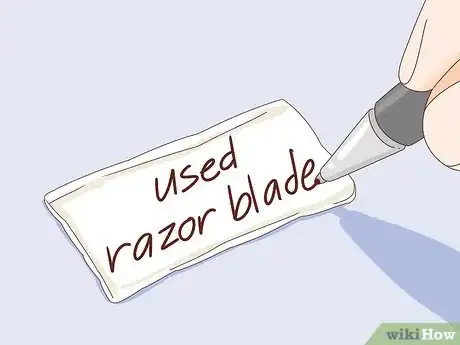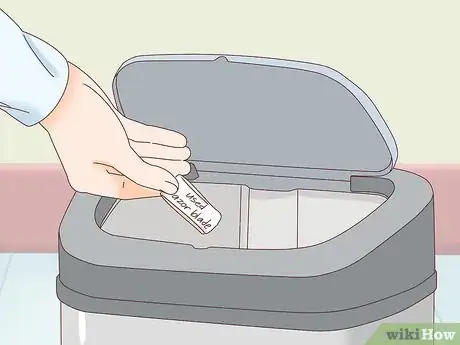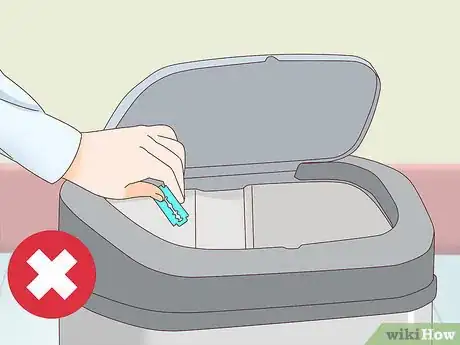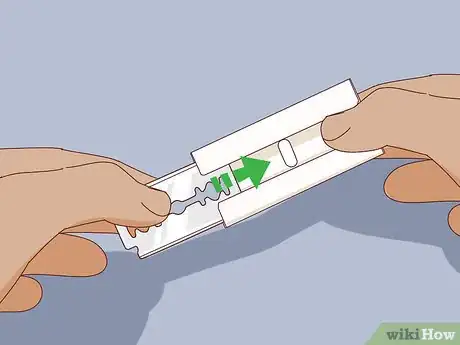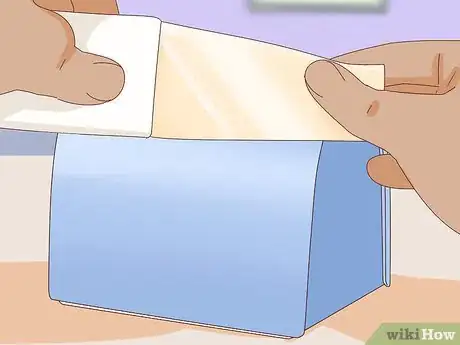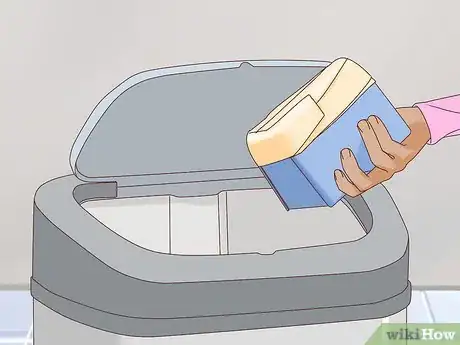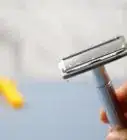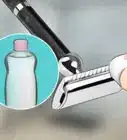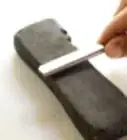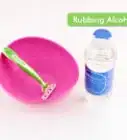This article was co-authored by Kathryn Kellogg. Kathryn Kellogg is the founder of goingzerowaste.com, a lifestyle website dedicated to breaking eco-friendly living down into a simple step-by-step process with lots of positivity and love. She's the author of 101 Ways to Go Zero Waste and spokesperson for plastic-free living for National Geographic.
There are 8 references cited in this article, which can be found at the bottom of the page.
This article has been viewed 40,666 times.
Whether your loose blade came from a safety razor, a disposable razor, or a utility knife – like an Xacto knife or a box cutter – you can dispose of it safely in 1 or 2 ways. The first option is to securely package up a single blade in stiff paper or cardboard. The second option is to designate a lidded container for the disposal of sharp objects, or sharps. Either way, seal up your container with duct tape and label it clearly. In most areas, it’s safe to include the container with the regular garbage.
Things You Should Know
- Recycle your blade by wrapping it up with tape and taking it to a recycling facility that works with metals.
- Wrap up single razor blades in heavy paper or cardboard and duct tape. Label the packet as a razor blade before tossing it out in the trash.
- Toss out multiple razor blades by placing them in a sharps container. Once it's full, tape and label the container before throwing it out.
Steps
Single Razor Blade Disposal
-
1Wrap the blade in multiple layers of heavy paper or cardboard. Tape the loose razor down onto a piece of cardstock or kraft paper.[3] Fold up the paper several times to conceal the entire blade, and duct tape the packet closed. Or tape the loose blade down securely onto a piece of cardboard that’s larger than the blade on all sides. Cover this up with another piece of cardboard and duct tape the packet shut.[4]
- You may also tape a layer of cardboard to either side of the heavy paper bundle for additional protection.
- Aim to keep the blade as securely packaged as possible. You don’t want to risk letting it come loose in the trash.
- Cover up the entire blade with paper or cardboard so that nothing remains exposed.
-
2Label the packet “sharps disposal” or “used razor blade.” Take a permanent marker and write your label directly onto the taped-up packet. Write the label on both sides of the packet to alert anyone who comes across is.[5]
- This is especially useful for homes and workplaces where someone else might dump out or pick up the contents to dispose of them.
-
3Put the labeled packet in with the regular garbage. Once your loose razor blade has been safely and securely wrapped up and labeled, in most cases you can throw it away with the rest of your trash.[6]
- Check to make sure this procedure complies with your local regulations before tossing the packet with the rest of the trash.
- Visit your local government’s website or speak call the sanitation company that serves your neighborhood to learn about any specific waste regulations you should abide by.
-
4Refrain from tossing a loose razor blade in the trash without any padding. You should never, under any circumstances, throw a loose razor blade into a wastebasket or garbage container without first packaging it up with paper or cardboard.
- A loose razor blade can be extremely hazardous those who inhabit your space, as well as the sanitation workers who handle your waste.[7]
- Shaving razors are also biohazardous and can spread disease if not disposed of correctly.
Multiple Blade Disposal
-
1Purchase a purpose-built sharps container for razor blade disposal. Some shaving razor brands manufacture their own “blade banks” that fit the shape and size of their products. Or you can purchase a generic sharps disposal container for your razor blades from most office supply stores and drugstores.[8]
- Sharps containers have a small lidded opening at the top through which you can drop in sharp objects.
- They’re often red and feature clear biohazard labels to alert others. For examples, refer to the FDA’s guidelines on approved sharps containers.[9]
- The advantage of a sharps container is that you can also use it for disposing of needles, thumbtacks, and other sharp, hazardous items.
-
2Make your own razor blade disposal box from a suitable lidded container.[10] As an alternative to a purpose-built sharps container, designate a small, empty container to use as your “blade bank.” Choose a container that’s made of a non-breakable and puncture-proof material and should also come with a secure lid. Label it clearly as “old razor blades” or “sharps disposal” to alert others to its contents.[11]
- Try a glass jar with a screw-on lid or a plastic safety-capped pill bottle.[12]
- You could also pick up an aluminum can of broth and cut a slit in the top to drain out the liquid. Rinse it out and drop single razor blades through the slit.
- A heavy-duty plastic piggy bank would also work. Just don’t use a ceramic bank since it could shatter.
- Avoid using anything made of cardboard or thin plastic, like a drinking cup or water bottle, since the blades will puncture the sides of the container.
-
3Insert old blades into the original packaging if it has a built-in disposal compartment. Some manufacturers sell new blades in a sturdy plastic container featuring a built-in disposal compartment. Typically the compartment will be located on the bottom of the container, with a thin slit on the side. Simply slide an old blade into the compartment when you go to take out a new one.
- The old blades aren’t likely to fall out of the container, but you should still use caution when handling it. Store it upright so that neither the new blades nor the old ones can fall out.
- If the blade packaging contains a disposal compartment, you won’t have to worry about purchasing or making your own disposal container.
- Only use this method for the blades that came in the packaging; don’t try to insert other types of blades as they may not fit.
-
4Store the disposal container in a safe place, out of the reach of children and pets. Whether you’ve chosen to use a sharps container or a homemade “blade bank,” keep it stored in a secure location to protect those around you. Make sure it can’t tip over or fall onto the floor, even if it has a tight lid.[13]
- For a public space or workplace, consider storing your sharps container near the garbage cans. Direct people to dispose of razor blades in the designated sharps container through announcements and clearly marked wall signage.
-
5Tape up and label your sharps container once it’s full. Wrap the lid onto the container using duct tape. Make sure it’s on so securely that it can’t possibly come off.[14] Write “sharps disposal” or “used razor blades” on all sides of the container with a permanent marker. This will alert sanitation workers and anyone else who handles your garbage that the contents of the box are hazardous.
- If you’re using a purpose-built sharps container, try your best not to cover over the biohazard labels with the duct tape.
-
6Throw away the sealed sharps container with the regular trash. If your local regulations permit it, you may add a safely sealed and labeled sharps container in with the rest of your garbage.[15] Some government agencies, pharmacies, and other third-party organizations will accept and dispose of sealed sharps containers.
- Browse through your local government’s website, speak with a representative from your neighborhood’s sanitation service, or visit a nearby pharmacy to see what’s possible in your area.[16]
Warnings
- Don’t attempt to recycle used razor blades. They’re far too small to process and may wreak havoc in a recycling center.[19] Some manufacturers may offer recycling programs for their safety razors, but don’t just toss a loose blade or even a whole safety razor into a recycling bin.[20]⧼thumbs_response⧽
References
- ↑ Kathryn Kellogg. Sustainability Specialist. Expert Interview. 28 June 2019.
- ↑ https://www.terracycle.com/en-US/brigades/gillette#@40.77027075200147:-95.93705549677736zoom:4
- ↑ Kathryn Kellogg. Sustainability Specialist. Expert Interview. 28 June 2019.
- ↑ https://greenopedia.com/recycle-razor-blades/
- ↑ https://www.calgary.ca/UEP/WRS/Pages/What-goes-where/Shaving-razor-blades.aspx
- ↑ https://greenopedia.com/recycle-razor-blades/
- ↑ https://www.toolsofmen.com/how-to-dispose-of-razor-blades/
- ↑ https://www.toolsofmen.com/how-to-dispose-of-razor-blades/
- ↑ https://www.fda.gov/medical-devices/safely-using-sharps-needles-and-syringes-home-work-and-travel/sharps-disposal-containers
- ↑ Kathryn Kellogg. Sustainability Specialist. Expert Interview. 28 June 2019.
- ↑ https://www.calgary.ca/UEP/WRS/Pages/What-goes-where/Shaving-razor-blades.aspx
- ↑ https://www.toolsofmen.com/how-to-dispose-of-razor-blades/
- ↑ https://www.toolsofmen.com/how-to-dispose-of-razor-blades/
- ↑ https://www.calgary.ca/UEP/WRS/Pages/What-goes-where/Shaving-razor-blades.aspx
- ↑ https://www.calgary.ca/UEP/WRS/Pages/What-goes-where/Shaving-razor-blades.aspx
- ↑ Kathryn Kellogg. Sustainability Specialist. Expert Interview. 28 June 2019.
- ↑ https://greenopedia.com/recycle-razor-blades/
- ↑ https://www.osha.gov/laws-regs/standardinterpretations/2005-03-28
- ↑ https://www.baydisposal.com/safely-dispose-razor-blades/
- ↑ Kathryn Kellogg. Sustainability Specialist. Expert Interview. 28 June 2019.

